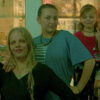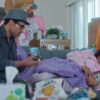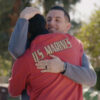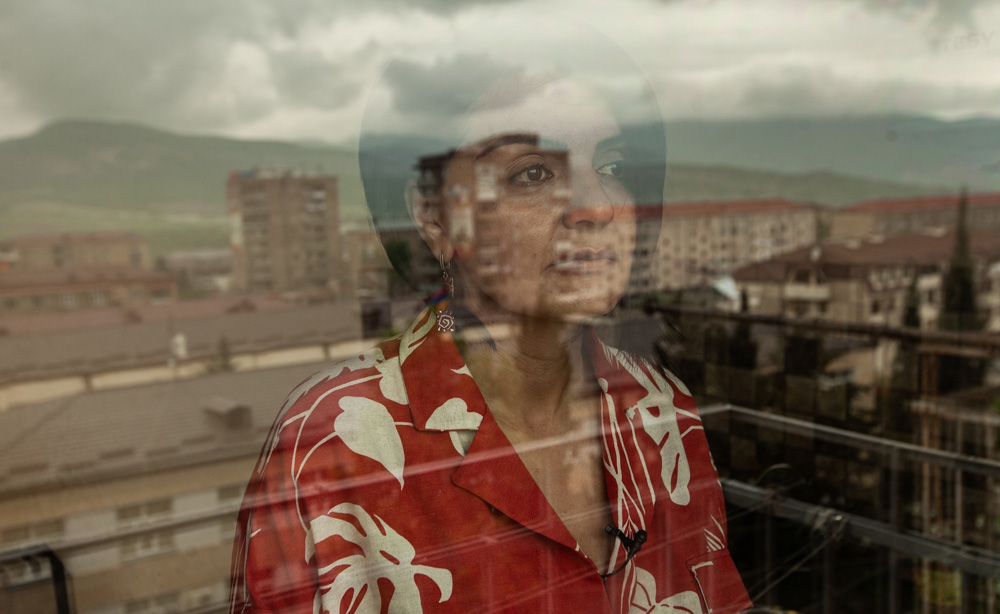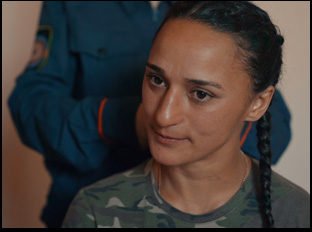When Emily Mkrtichian began filming on “There Was, There Was Not,” it wasn’t unreasonable to think she was bearing witness to something being built. In the Republic of Artsakh, she found a collection of women that were attempting to break tradition as she followed the kickboxer Sosé, who aspired to represent her homeland at the Olympics, Gayane, who was cultivating community with a women’s center, Siranush, whose run for city council was breaking new ground even if she didn’t win and Sveta, who simply wanted her children inoculated from the region’s difficult past so they could focus on the future, and in a place of breathtaking natural beauty, it could be easy to overlook the frustratingly all-too-human conflicts that have put it in peril time and again. As it would turn out, however, Mkrtichian would chronicle the destruction of Artsakh, never recognized as a proper country when the land was long fought over by neighboring countries Armenia and Azerbaijan and aggression by the latter shortly before 2020 forced out the indigenous Armenian population and made it too dangerous to return.
“I wanted to make something that could be handed down to another generation,” Mkrtichian said recently of her magnificent feature debut, the tactile power of what she captured taking on an entirely different kind of weight when the film could be the only images that her subjects could refer back to as preserved memories besides what they could share with words. Having the film’s title reference the way fairy tales have been introduced for centuries in Armenia, “There Was, There Was Not” inserts itself into a grand storytelling tradition where history is passed on in a way where emotion matters as much as fact.
For many reasons, it seems appropriate that “There Was, There Was Not” opens with the director putting on a cezve to make coffee before relating the kind of tale to curl up to, stirring the grounds around as if to arouse the senses in a process that never stops during the film’s runtime. Although Mkrtichian has devastating footage of Artsakh under siege, causing all her subjects to put their plans to the side and in Sosé’s case, enlisting for combat, the feeling of what’s been lost is conveyed just as strongly in how vividly she is able to express their aspirations, with the sight of dreams crumbling as painful if not more to watch than buildings cut down to size yet holding the hope that what can be rebuilt in the imagination can eventually manifest itself in the physical world. After premiering earlier this year at True/False, the film is arriving in New York this week to play at DOC NYC and Mkrtichian graciously took the time to talk about adjusting to the more tragic story she ended up following, her collaboration with “On Her Shoulders” director Alexandria Bombach as an editor on the film, and why it was only complete when seen through the eyes of others.
I made a short film in Artsakh that I started filming in 2014, which was just about the first group of women who were removing landmines. I was living in Armenia at the time, but I just really was taken aback by the women of Artsakh. They had this very specific strength and this incredible sense of humor, and they seemed to be doing these jobs that might be dangerous or difficult. They seemed to be the people who were pushing forward the most progressive ideas, and yet they weren’t being recognized as such in their society, which is often a legacy of conflict. Most countries that have experienced major conflicts have these issues with what are women’s role in society, so I was really interested in that dynamic and this idea that these are the strongest, funniest, some of the most interesting women I’ve ever met, and they seem to be holding their communities together and pushing it forward, but they don’t necessarily have the same rights and freedoms as other people.
How did you end up following the four women that you do?
My intention in the beginning of making the film was just to spend lots of time in the place, meeting people and having conversations. Many of the women are friends of friends, and as I spent more and more time in this place, it really felt that these women just organically showed up in my life and embodied very different things about the country. It was important to me that I was following women who were of different generations and who did different kinds of work. They were people that I personally was drawn to, as an Armenian woman and as a filmmaker for lots of different reasons, so I just let that guide me.
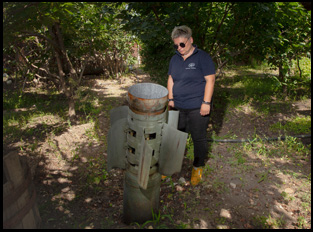
That was hard to negotiate because originally I wanted it to be a very observational film. But when the war happened, it immediately changed the dynamic. The camera became a tool of power, and the women began speaking to the camera in much more deliberate ways. I became aware of my role and responsibility as the one with the camera in those moments over those weeks and years. So in the edit of the film, it was actually really intentional to have the audience know that there was someone behind the camera from the beginning in small and subtle ways, and to have that evolve when the war happened. For me, it felt almost like an ethical stance to be clear that the person behind the camera did not set out to make a film about war and there was a real person who was also affected by all of these things that happened. I was seeing so many people come in with the intention of making a film just about the conflict, and it felt like such a detached way to make a film [when] I was very attached to these people when I was affected by what happened.
There’s a stylistic break in the film when the war starts. You don’t have any traditional sit-down interviews before it and what you do isn’t exactly traditional in setting up a chair in a field to talk to your subjects, but how did that decision come about to afford everyone the chance to directly address the camera?
We filmed those at the one-year anniversary of the war ending, and in in that period of time, I was really struggling with what does it mean to unexpectedly make a film about conflict and document people whose lives are falling apart. It was hard to say something about that as a filmmaker, partially because it wasn’t my original intention but also because we were all still trying to figure out what had happened and what it meant. I really wanted to give each of the women the time and space to reflect on it themselves instead of offering through either the voice of the film or through the editing to offer my own perspective. All four of the women and I have had conversations throughout this process of how we didn’t want it to be a specific kind of film about war. We didn’t want it to focus on just the traumatic experience and the loss. We really needed it to document the joy, the reality and the life lived in a place as a document that could live into the future, so I wanted them to have the ability to speak to that on their own terms.
That [also] was the beauty of the collaboration with [my editor] Alexandria Bombach is that I was really [felt] that we must adhere to this very classic verite style, but I would describe emotional experiences to them and we would have these long conversations about the feeling of what I wanted. For example, [I wanted] this rupture moment in the center of the film to feel like it has this sense of nostalgia and reflection and a very deep feeling that I think all four women in the film and myself shared, which is that I wish it had never happened.
Then as a storyteller, walking from the beginning of the film where I’m really just showing you the beauty of a place and these women’s fight to make it better, there was always a hesitation in the editing process of how do I show this? I don’t even want to show you this, and I don’t want to show you these women going through this, but there is a necessity to show the truth of what happened, to learn from the historical record and to find some sort of meaning in it ultimately. So Alexandria has this amazing ability to communicate an emotion through the editing process that I was really just in awe of. Those moments where we break the verite style are great examples of that and how these more artistic ways to work with images can evoke a larger feeling or sentiment.
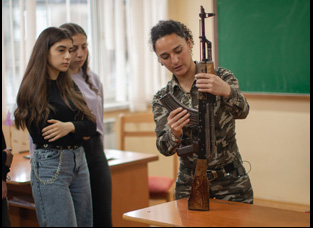
The connection that I drew between my own lineage and what had happened in my lifetime was something that I didn’t expect necessarily to come from the filmmaking process. My grandparents had been displaced and I’m first generation in the U.S., but that lives in me through my DNA but not something that I felt on my skin, so experiencing displacement again and watching women restart their lives and thinking about what that might mean for their children and their future lineages and different generations made me reflect on the filmmaking process in a very new and different way.
It’s got such a brilliant opening. How did you end up figuring out how to frame this?
That was the hardest part of the film because a lot of the observational scenes of the film were already built and we knew that it needed a beginning to get people in. That reflection that I was just talking about on my own lineage and what had unfolded in front of me became a way to invite people into this story that could feel bigger, feeling like something many people from other backgrounds had experienced. In the way that the women make themselves very vulnerable on camera, it felt like a way that I could make myself as a filmmaker vulnerable and show my own cards and invite people into a larger story that then became very particular.
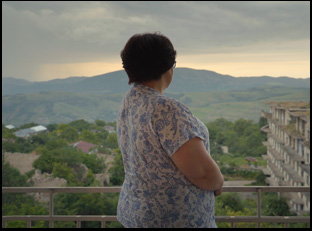
It was really hard. I was really nervous about it. The first person I showed was Sose before the premiere at True/False. We were sitting in the hotel room together watching the film, and the beautiful part was the first 40 minutes of the film they were just taking photos, like, “Oh, my grandma in this house in this place,” and in that moment of showing Sose the film for the first time, I realized that this film is a document of a place that we can’t get back to. It exists as a part of a finite archive of images of a place and a life, so showing this film to the women has been really important for me because it allowed us together to reexperience a place and the joy of a place. And I found that in screenings of the film, especially with people from Arsakh and Armenia, that it’s been cathartic. It’s a way for us to hold on to some of the joy of that place that can’t be taken away and that this film is a testament to.
And people have been saying to me lately, when you finish the film, like when you lock the edit and you do your premiere, you’re actually at the halfway point and I think that’s really true. Film is meant to be experienced together. It’s meant to be shared, and the distribution of this film is really important to me in so many ways. I did not feel right when I finished the film that it was the cathartic healing process that I hoped it would be. But when I show the film in a theater with people and we watch it together and we talk about it afterwards, I truly feel the healing power of creative work. That has been the way that this film has given back to me. I have now seen things in my life that count among the most terrible things that you could see on the planet, and that is not something I was prepared for. But the making of this film and even more importantly sharing it with others has brought meaning to that experience.
“There Was, There Was Not” will screen at DOC NYC at the Village East on November 18th at 6:45 pm and November 20th at 9 pm. It will be available virtually from November 19th through December 1st via the DOC NYC online platform.
